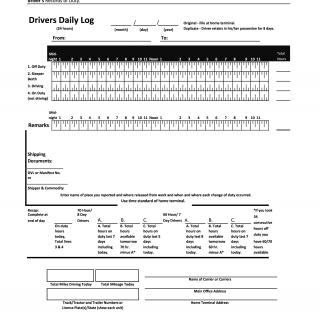Drivers Daily Log Form
The Drivers Daily Log form is a critical document used by commercial drivers to meticulously record their activities, duty status changes, and driving hours over a 24-hour period. This log is designed to ensure compliance with regulations and maintain accurate records of a driver's work schedule and driving hours. Here is an overview of the key components of the Drivers Daily Log:
Format and Time Tracking:
- The log is divided into a 24-hour grid, allowing drivers to document their activities and duty status throughout the day.
- The top of the form includes spaces to input the date (month, day, year) and specifies whether it is the original or duplicate copy of the log.
Duty Status Categories:
- The log categorizes duty status into five main categories:
- Off Duty
- Sleeper Berth
- Driving
- On Duty (not driving)
- Remarks
Recording Activities:
- Drivers indicate the times they change their duty status within each hourly slot, which helps create a detailed timeline of their activities.
Recap and Calculation:
- At the end of the day, drivers complete the "Recap" section, summarizing their hours.
- The recap calculates total on-duty hours, driving hours, and available hours based on specific regulations, such as the 70-hour and 60-hour rules.
Carrier Information:
- The form requires drivers to provide the name and address of the carrier or carriers they are associated with.
Vehicle Details:
- Drivers input the total miles driven during the day and the corresponding total mileage.
- The truck/tractor and trailer numbers, as well as license plates and state information, are documented.
The Drivers Daily Log form plays a vital role in promoting road safety and regulatory compliance within the transportation industry. By accurately recording their activities and duty status changes, commercial drivers help ensure that they adhere to legal driving hour limits, reducing the risk of fatigue-related accidents and maintaining the integrity of the transportation system.

